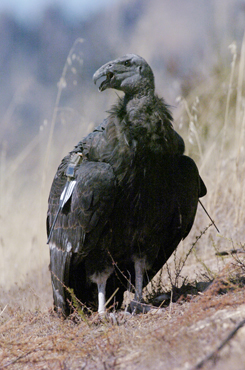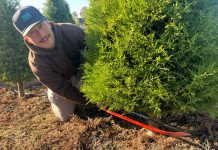
Ventana Big Sur birds get $75,000 for new flight pen, but rare
species still struggles with lead
While condors in Big Sur will soon have a bigger, better flight
pen, the imperiled birds still will have to contend with lead
poisoning from bullets.
Ventana Big Sur birds get $75,000 for new flight pen, but rare species still struggles with lead
While condors in Big Sur will soon have a bigger, better flight pen, the imperiled birds still will have to contend with lead poisoning from bullets.
This week, the National Fish and Wildlife Foundation awarded the Ventana Wildlife Society $75,000 in federal grant money, earmarked for the Society’s bid to build a new and larger aviary for their flock of California condors, a species that in 1988 was on the brink of extinction. The grant will be coupled with $150,000 in matching funds for the group’s condor release program, an effort that has been wildly successful since the early 1990s.
“We’re thrilled that we’re going to be able to further support the recovery of the California condor by being able to release more birds to the wild,” said Kelly Sorenson, Executive Director of the Ventana Wildlife Society. His group was one of the first to release condors back in the wild in California, starting in 1997. In 2002, the Pinnacles National Monument also became a condor release site.
Sorenson said the larger flight pen at Big Sur will serve as a pre-release aviary for condors due to soar above both recovery sites.
News about the grant was heralded by Rep. Sam Farr, D-Monterey, a cheerleader for the recovery programs in his district, both in Big Sur and at the Pinnacles National Monument in San Benito County.
“This grant is great news, especially following on recent sightings of nesting and feeding condors along the Big Sur coastline.” Farr said. “The Ventana Wildlife Society has been instrumental in bringing us to this point where we can seriously anticipate the resurrection of a species we once thought was lost forever.”
But the news comes on the heels of a decision made days earlier by the California Assembly. A bill to limit the use of lead bullets – the bane of condor recovery efforts throughout California, Baja California and Arizona – was shot down as legislators laughed the idea off the Assembly floor.
Condors, eat only dead animals and are susceptible to lead poisoning when they ingest fragments from shattered, spent bullets left in hunters’ gut piles. A micro-bit of lead the size of a pinhead can cause a condor to go blind, lose motor skill and the ability to digest anything. Dozens of condors in the early days of the reintroduction program died from lead poisoning.
Biologists must constantly monitor the free-flying birds for the toxin, and if need be, put them through a painful blood chelation process to purge the lead. Two weeks ago, two condors from the flock at the Grand Canyon in Arizona died of lead poisoning, and biologists there have had to administer 77 chelation treatments to the birds since 1997.
The bill would have supplied hunters roaming through Los Padres National Forest (a condor corridor) with lead-free ammunition at no cost, and for the effects of the effort to be monitored over a three-year period. It had been introduced by Assemblyman Pedro Nava, D-Santa Barbara, but was voted down 6-8 by the Water, Parks and Wildlife Committee. Opponents to the bill argued that there was still a “question mark” as to what was causing the lead poisoning in the condors, and that it could very well be caused by lead in the atmosphere – though lead was banned in gasoline, as well as paint, years ago.
“It was so absurd it was laughable,” said Sorenson, who attended the Sacramento hearing.
There are currently 55 free-flying condors in California; the Ventana Wildlife Society is responsible for releasing 38 of those birds into the wild.









